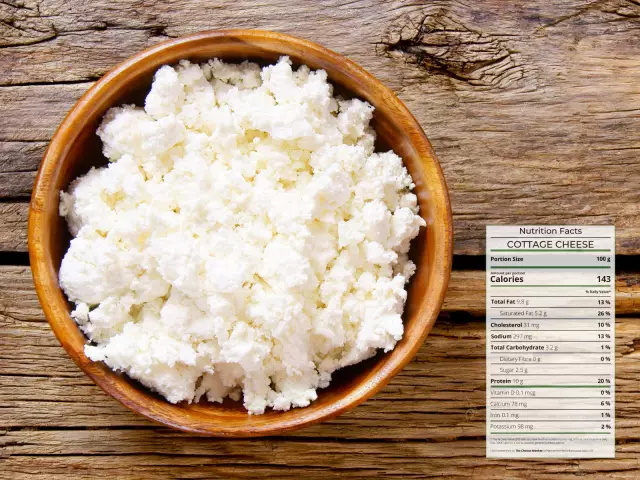- Author Rachel Wainwright [email protected].
- Public 2023-12-15 07:39.
- Last modified 2025-11-02 20:14.
Brie cheese

Any cheeses, like fermented milk products, are certainly good for humans. But there are varieties that are more than useful for the body, as they contain not only important elements, but also medicinal ones. One of these products is brie cheese, covered with a white bloom, from which the antibiotic penicillin is isolated.
Brie cheese composition
Brie cheese contains essential amino acids. They are called so because they are not synthesized inside the body and are not replaced by anything else.
Amino acids in brie cheese and their role in the human body:
- Tyrosine - participates in the synthesis of important hormones: adrenaline, melanin and dopamine;
- Tryptophan - ensures the production of serotonin, an anti-stress hormone;
- Methionine - is part of the liver enzymes responsible for the neutralization of toxic substances.
Due to the high content of these amino acids, mood improves without additional doping, although gourmets recommend using brie cheese with Champagne. How can cheese improve your mood?
Elementary. Adrenaline raises the tone, because it accelerates all vital processes. Dopamine acts directly on the pleasure center, which is located in the cerebral cortex. At the same time, melanin smooths out the action of adrenaline, eliminating unnecessary effects such as an increase in blood pressure. Serotonin adjusts the digestive system to calmly digest food, eliminating stress factors that contribute to the development of gastric and duodenal ulcers. Finally, methionine provides positive emotions from the process itself - the intake of brie cheese in food.
The cheese contains a sufficient amount of polyunsaturated fatty acids, which are involved in the production of steroid hormones, including sex. Acids are called fatty only by their chemical formula - it is impossible to gain weight by eating brie cheese, the calorie content of which is about 300 Kcal. According to the calculations of people who are fond of diets, this number of kilocalories corresponds to one glass of sweet iced tea.
The most important trace element is calcium, due to the sufficient content of which the work of the following organs and systems is ensured:
- Neuromuscular transmission: conscious movements, including the use of fine motor skills. When "jewelry work", for example;
- Automatism and contractility of the heart muscle;
- Strengthening the walls of blood vessels in order to prevent varicose veins and hemorrhoids;
- Prevention of destruction of tooth enamel with the development of caries;
- Strengthening bone tissue - especially important for the elderly and athletes.
Finally, about the most important element of brie cheese, which is present only in its composition, unlike other cheeses. This is a white deposit called mold. And this name is more microbiological than colloquial. A delicate and thin white film on the surface of the cheese is not a fungal mold growing on damp walls, but the finest structure, inside which small mycelium ripen. They are the precursors of penicillin. The pharmacological action of the mold film is much lower than that of solutions and tablets of penicillin, but it is enough to suppress the activity of Staphylococcus aureus, which accidentally got into food.
Brie cheese: recipes
Brie cheese recipes were developed in the province of the same name in France during the Louis dynasty. Today, soft brie cheese is also prepared using a similar technology in other European countries and even in the United States of America. Americans, as is their nature, use all sorts of improvements and modifications: they add mushrooms, nuts, herbs. However, according to the real recipe, brie cheese is made only in France.
All brie cheese recipes are not trade secrets, but their exact repetition does not provide such taste and health benefits. The fact is that this product is prepared by hand from raw materials (cow's milk) obtained in France. An American or Kholmogory cow gives the same milk composition, but not the same quality. The grass in other parts of the world is somewhat different. In addition, after separating the whey, it is salted and placed in special cellars. They contain the necessary fungi, which turn into a white film on the surface of the cheese.
The finished product is stored in refrigerators, and before use, be sure to give time to warm up to room temperature. Only after this does the product acquire a unique taste reminiscent of a nut. These are the recipes for brie cheese, a product not only exotic, but also the most useful.
Additional properties of soft brie cheese
Brie cheese is useful not only for the important substances that it contains, but also for the absence of components that are harmful or potentially hazardous to health. So, in soft brie cheese there is no glucose, which allows diabetics to eat it. Also, due to the action of the mold film, the main element of dairy products - lactose - enters the human body in a bound state. This fact cannot go unnoticed for persons who cannot tolerate milk and slightly acidic dairy products.
Everything is good in moderation
The relatively low calorie content of brie cheese is not enough to be limited to one bite for the whole day. However, increasing the dose does not cover energy costs; on the contrary, it increases the load on the body.
The penicillin mycelium contained in the noble mold is dangerous for people who cannot tolerate these antibiotics. Eating small amounts of mold cheese can trigger an allergic reaction.
For persons suffering from dysbiosis, mold cheese is also contraindicated. An additional intake of an antibiotic, even its predecessor, aggravates the course of the disease. The normal intestinal microflora dies, and conditionally pathogenic bacteria multiply due to active division. However, dysbiosis is a temporary condition. After its treatment, contraindications for eating mold cheese are removed.

Delicious soft brie cheese is recommended for people under the influence of sunlight: on the beaches. The accelerated production of melatonin protects the skin from sunburn. A person rests, the tan lays down evenly, the mood remains elevated, because such a little as the use of brie cheese solves the problem of acquiring sunburn creams and the consequences of sunburn. At the same time, excessive consumption of blue cheese leads to intestinal upset due to exposure to the noble mold containing the precursor of penicillin.
Brie cheese, exotic or everyday?
The gourmet brie cheese with mold was a favorite delicacy of the French kings, who respected it and consumed it on holidays. Today we have the opportunity to serve a royal dish to the table, both for a big celebration and as an ordinary breakfast. The high price compensates for the pleasures guaranteed by brie cheese, the calorie content of which does not cause concern for the safety of the figure. And yet, mold cheese is not a simple fermented milk product, but a kind of medicine, and it is not recommended to exceed its dosage.
Found a mistake in the text? Select it and press Ctrl + Enter.






